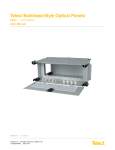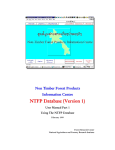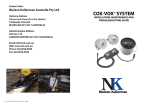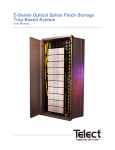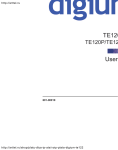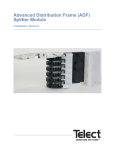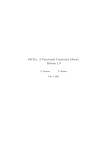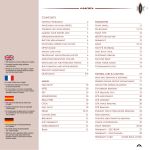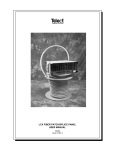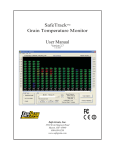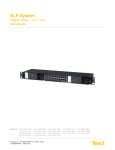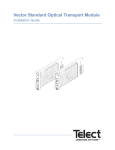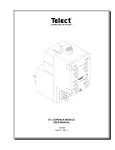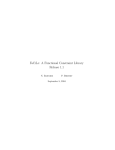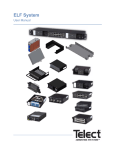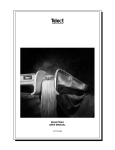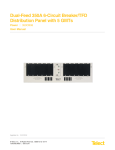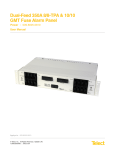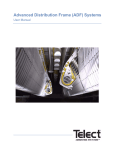Download Bulkhead-Style Fiber Optic Panels User Manual
Transcript
Telect Bulkhead-Style Optical Panels - LCX Series User Manual Telect Bulkhead-Style Optical Panels - LCX Series User Manual, Part Number 126254-4 Copyright 2010, Telect, Inc., All Rights Reserved Telect and Connecting the Future are registered trademarks of Telect, Inc. 1730 N Madson St., Liberty Lake, Washington Telect assumes no liability from the application or use of these products. Neither does Telect convey any license under its patent rights nor the patent rights of others. This document and the products described herein are subject to change without notice. About Telect Telect offers complete solutions for physical layer connectivity, power, equipment housing and other network infrastructure equipment. From outside plant and central office to inside the home, Telect draws on more than 25 years of experience to deliver leading edge product and service solutions. Telect is committed to providing superior customer service and is capable of meeting the dynamic demands of customer and industry requirements. This commitment to customer and industry excellence has positioned Telect as a leading connectivity and power solution provider for the global communications industry. Technical Support E-mail: [email protected] Phone: 888-821-4856 or 509-921-6161 Telect, Inc. • USA +1.509.926.6000 • Mexico +52.33.3836.37.52 www.telect.com • © 2010 Telect, Inc., All Rights Reserved, 126254-4 A0.1 Page ii Telect Bulkhead-Style Optical Panels - LCX Series User Manual Table of Contents Chapter 1: Description .............................................................................................................. 1 1.1 Overview .......................................................................................................................... 1 1.1.1 Features .................................................................................................................. 1 1.1.2 Capacities/Capabilities/Suitability ........................................................................... 2 1.1.3 Benefits ................................................................................................................... 2 1.1.4 Applications ............................................................................................................. 2 1.2 LCX Fiber Panels ............................................................................................................. 3 1.2.1 General Information ................................................................................................ 3 1.2.2 LCX Fiber Splice Panels .......................................................................................... 4 1.2.3 LCX Fiber Patch Panels ........................................................................................ 10 1.3 Special Function Modules .............................................................................................. 13 1.4 Specifications ................................................................................................................. 14 1.4.1.Overall Dimensions ............................................................................................... 14 1.4.2 Environment .......................................................................................................... 14 1.4.3 Mounting ............................................................................................................... 14 1.4.4 Cable Compatibility ............................................................................................... 15 1.4.5 Adapter Choices..................................................................................................... 15 1.4.6 Optical Protections ................................................................................................ 15 1.4.7 Optical Performance ............................................................................................. 15 1.4.8 Compliance ........................................................................................................... 15 1.4.9 Certification ........................................................................................................... 15 Chapter 2: Applications ........................................................................................................... 21 2.1 Interconnecting IFC to Network Elements ...................................................................... 21 2.2 Interconnecting Network Elements ................................................................................ 21 2.3 Cross-Connecting Network Elements ............................................................................ 22 2.4 Cross-Connecting Combinations ................................................................................... 22 2.5 Interconnecting & Cross-Connecting Along with Special Function Modules .............................................................................................. 24 Chapter 3: Panel Installation ................................................................................................... 27 3.1 Installation Considerations ............................................................................................. 27 3.1.1 Location & Space .................................................................................................. 27 3.1.2 Tools & Equipment ................................................................................................ 27 3.1.3 Inspection .............................................................................................................. 27 Telect, Inc. • USA +1.509.926.6000 • Mexico +52.33.3836.37.52 www.telect.com • © 2010 Telect, Inc., All Rights Reserved, 126254-4 A0.1 Page iii 3.2 Panel Installation (All Except 1RU) ................................................................................ 28 3.3 1RU Panel Installation ................................................................................................... 32 Chapter 4: Fiber Installation ................................................................................................... 35 4.1 Fiber Installation Overview ............................................................................................. 35 4.2 Fiber Installation Procedures (All Except 1RU) .............................................................. 36 4.2.1 Splicing (All Except 1RU) ...................................................................................... 36 4.2.2 Patching (All Except 1RU) ..................................................................................... 41 4.3 1RU Fiber Installation .................................................................................................... 42 4.3.1 1RU Splicing ......................................................................................................... 42 Chapter 5: Services ................................................................................................................. 47 5.1 Owner Maintenance ....................................................................................................... 47 5.2 Technical Support .......................................................................................................... 47 5.3 In-Warranty Service ....................................................................................................... 47 5.4 Out of Warranty Service ................................................................................................. 47 5.5 Repacking for Shipment 48 5.6 High Insertion Loss and the Importance of Cleaning Connectors & Adapters ................................................................................... 48 Chapter 6: Accessories ........................................................................................................... 49 6.1 Accessories and Replacement Parts ............................................................................. 49 List of Figures Figure 1 - LCX Fiber Patch Panel (4RU) ..................................................................................... 1 Figure 2 - LCX Fiber Panels (Common Physical Features of 2RU Through 4RU Panels) ........................................ 3 Figure 3 - LCX 1RU Fiber Panel .................................................................................................. 4 Figure 4 - 1RU Fiber Splice Tray ................................................................................................. 5 Figure 5 - 1RU Splice Tray (Right Corner Tray) .......................................................................... 5 Figure 6 - 1RU Splice Tray - Fiber Routing .................................................................................. 6 Figure 7 - 1RU Cable Clamp Fits 12 to 24 Fiber IFC ................................................................... 6 Figure 8 - LCX Splice Panel, 2RU — 24 Termination Capacity ................................................... 7 Figure 9 - LCX Splice Panel, 3RU — 48 Termination Capacity ................................................... 7 Figure 10 - LCX Splice Panel, 4RU — 72 to 96 Termination Capacity ........................................ 8 Figure 11 - Splice Tray (Right Corner View) ................................................................................ 8 Figure 12 - Splice Tray (Fiber Routing) ........................................................................................ 9 Figure 13 - Optional Cable Clamp Fits All Sizes of IFC ............................................................... 9 Figure 14 - LCX Patch Panel, 1RU — 12 Termination .............................................................. 10 Figure 15 - LCX Patch Panel, 2RU — 24 Termination .............................................................. 11 Figure 16 - LCX Patch Panel, 3RU — 48 Termination .............................................................. 11 Telect, Inc. • USA +1.509.926.6000 • Mexico +52.33.3836.37.52 www.telect.com • © 2010 Telect, Inc., All Rights Reserved, 126254-4 A0.1 Page iv Figure 17 - LCX Patch Panel, 4RU — 72, 96, or 144 Termination ............................................ 12 Figure 18 - Patch Plates ............................................................................................................ 12 Figure 19 - WDM & Splitter Modules ......................................................................................... 13 Figure 20 - 1RU LCX Chassis .................................................................................................... 16 Figure 21 - 2RU LCX Chassis .................................................................................................... 17 Figure 22 - 3RU LCX Chassis .................................................................................................... 18 Figure 23 - 4RU LCX Chassis ................................................................................................... 19 Figure 24 - Pull-Out & Swing-Out Clearances ........................................................................... 20 Figure 25 - Interconnecting/Splicing Facility Cable to Network Elements .................................. 21 Figure 26 - Interconnecting Network Elements in a LCX Fiber Patch Panel ............................. 21 Figure 27 - Cross-Connecting Network Elements ...................................................................... 22 Figure 28 - Cross-Connecting IFC to Network Elements ........................................................... 23 Figure 29 - Interconnecting/Cross-Connecting Along with WDM/Splitter Modules .................... 25 Figure 30 - Removing Knockouts & Installing Plastic Grommets ............................................... 28 Figure 31 - Installing a Standard Split Arc ................................................................................. 29 Figure 32 - Installing a Standard Isolation Hook Kit ................................................................... 29 Figure 33 - Installing An Optional Arc Kit ................................................................................... 30 Figure 34 - Mounting LCX Panel to Rack .................................................................................. 30 Figure 35 - Installing Adapter Pack & Special Function Modules .............................................. 31 Figure 36 - Inserting Cabling Rings .......................................................................................... 31 Figure 37 - Cable Restraint Layout (Top View of Chassis Bottom) ........................................... 32 Figure 38 - Mounting 1RU LCX Panel to Rack .......................................................................... 32 Figure 39 - Mounting 1RU LCX Combo Panels to Rack ............................................................ 33 Figure 40 - Installing Patch Plates & Special Function Modules in a 1RU ................................. 33 Figure 41 - IFC Breakout Length (2RU through 4RU) ............................................................... 36 Figure 42 - IFC Clamp ............................................................................................................... 37 Figure 43 - Installing IFC for Splicing ......................................................................................... 37 Figure 44 - Cable Placement and Securing ............................................................................... 38 Figure 45 - Splice Tray (Right Corner View) ............................................................................. 39 Figure 46 - Splice Tray (Fiber Routing) ...................................................................................... 40 Figure 47 - Installing Interconnects or Cross-Connects in an LCX Fiber Patch Panel .............. 41 Figure 48 - IFC Breakout Length (1RU) ..................................................................................... 42 Figure 49 - Installing an IFC for a LCX 1RU Panel .................................................................... 43 Figure 50 - Cable Routing .......................................................................................................... 44 Figure 51 - 1RU Splice Tray (Right Corner Tray) ...................................................................... 45 Figure 52 - 1RU Splice Tray (Fiber Routing) ............................................................................. 45 Figure 53 - Cleaning the Adapter ............................................................................................... 48 Telect, Inc. • USA +1.509.926.6000 • Mexico +52.33.3836.37.52 www.telect.com • © 2010 Telect, Inc., All Rights Reserved, 126254-4 A0.1 Page v Chapter 1: Description 1.1 Overview Telect’s LCX Patch/Splice Panel Systems provide interconnectivity and crossconnectivity of riser/plenum and network element fiber cabling. Panels provide a central location for patching, splicing, testing, troubleshooting, monitoring, and restoring service to fiberoptic systems. LCX panels fit standard 19and 23-in. (EIA/WECO Figure 1 - LCX Fiber Patch Panel (4RU) spacing) and ETSI racks. 4RU panels support up to 144 terminations. LCX Patch Panels and Splice Panels provide a total solution as well as standalone splice and patch capabilities. All Telect LCX panels are system compatible with standard LGX® style panels, thereby serving as replacements or add-ons in system solutions of other manufacturers. Patch adapter terminations include SC/UPC and APC, and FC/UPC and APC, LC/UPC, and ST/UPC. LCX Patch Panels are available with or without fiber adapters. Telect offers patch plates with 6, 8, or 12 adapters per plate for on-site configuration. The 1RU through 4RU LCX Patch Panels also accept standard Wavelength Division Multiplexing (WDM), splitter, and monitor modules. 1.1.1 Features Telect manufactures LCX Patch Panels and Splice Panels to suit any system architecture. Features include • Design for compliance (fiber bend-radius control, flammability safety, structural reliability). NEBS 3 and ETSI certification • Zone 4 Seismic reliability • Light weight • Easy removal of splice tray for rapid termination of cable • No cassette requirement. Removable trays provide for easy and direct storage and splicing. • Easy access via removable front and rear doors or bi-directional sliding drawer Telect, Inc. • USA +1.509.926.6000 • Mexico +52.33.3836.37.52 www.telect.com • © 2010 Telect, Inc., All Rights Reserved, 126254-4 A0.1 Page 1-1 1.1.2 Capacities/Capabilities/Suitability • LCX panels are available for universal 19-in., 23-in., and ETSI racks. • You can have 12, 24, 48, 72, 96, or 144 (LC) termination capacities per panel (1RU through 4RU) using site-installed patch plates. There are up to 144 per panel with factory-installed discrete adapters. • Standard-size 6, 8, or 12 adapters are available per patch plate for on-site patch panel adaptation of empty panels. • SC/UPC, SC/APC, FC/UPC, FC/APC, LC/UPC, and ST/UPC patch plates are available. • Standard-size Wavelength Division Multiplexing (WDM) and splitter modules can be used along with adapter packs for added flexibility. • All LCX Patch/Splice Panels are fully compatible with standard LGX® style panels for IFC entrance, splicing, and network patching architecture. • All LCX panels are compatible with Telect’s WaveTrax cable management systems, as well as those of other manufacturers. • 2RU through 4RU models include slip-on, split arcs for patch cord entrance; optional cable management kits are available to suit operating company preferences. 1.1.3 Benefits Telect’s LCX Splice/Patch Panels are ideal for central office, head-end and wiring centers. Benefits include • Low cost — High Fiber Density — Versatility • Easy Installation • Compatibility • Simple, straight-forward cable management, access, circuit identification, and isolation • Easy access to riser/network/patch cord connections 1.1.4 Applications • CATV • MTSO • Outside plant • Central Office • Optical distribution/cross-connect Telect, Inc. • USA +1.509.926.6000 • Mexico +52.33.3836.37.52 www.telect.com • © 2010 Telect, Inc., All Rights Reserved, 126254-4 A0.1 Page 1-2 1.2 LCX Fiber Panels 1.2.1 General Information Telect manufactures LCX Fiber Splice Panels and LCX Fiber Patch Panels of various densities to suit company-wide fiber splice, patching, and routing requirements. All LCX Fiber Panels are white or black metal chassis in various sizes (1RU through 4RU) accommodating various fiber densities. All panels (2RU - 4RU) come equipped with front and rear metal doors. All include cable entry/exit points near the panels’ four corners: • 2RU through 4RU models vary in density from 24 to 144 fiber terminations. All have springhinged removable front and rear doors, as shown in Figure “LCX Fiber Panels (Common Physical Features of 2RU Through 4RU Panels)” on page 3. Knock-out holes at the top and bottom of the panel allow for routing from splice panels to patch panels (and between patch panels) vertically within the rack. Hole pattern and positions are compatible with panels offered by other manufacturers, allowing expansion and replacement of those systems using Telect’s low-cost LCX panels. Figure 2 - LCX Fiber Panels (Common Physical Features of 2RU Through 4RU Panels) • Interconnection and cross-connection cabling from above or below enter at the two front corners of each Telect LCX panel via isolation hooks and/or radius control arcs installed on-site to suit the application and entry/exit direction. Eight split arcs and fourteen snap-in cable rings are standard with each panel. Telect also offers two optional kits to satisfy cable management practices requiring multiple arcs or guide posts to separate and isolate groups of fiber cables. • 1RU models have densities up to 24 fiber terminations. Instead of front and rear doors, 1RUs have a removable sliding drawer that can be extended at the front or rear of the chassis to maximize access to fiber connections. Pivoting arcs at corner entries and exits provide cable Telect, Inc. • USA +1.509.926.6000 • Mexico +52.33.3836.37.52 www.telect.com • © 2010 Telect, Inc., All Rights Reserved, 126254-4 A0.1 Page 1-3 management. Entry and exit positions are compatible with entries and exits of other Telect LCX panels and those of other manufacture. Figure 3 - LCX 1RU Fiber Panel 1.2.2 LCX Fiber Splice Panels Telect offers four sizes of LCX Fiber Splice Panels (1RU through 4RU) to accommodate up to 144 splices. Each removable splice tray holds up to 24 splices along with 1½ m of fiber cable storage: • For a 1RU splice tray, all fiber (subunit, cable, and strands) is stored on the tray. • For a 2RU, 3RU or 4RU splice tray, all subunit and interconnection cable storage is below the trays. Trays easily slip free of the panels to allow splicing. Storage spools or arcs, along with splice holders, are mounted directly on the tray, eliminating the need for special splice cassettes. Telect, Inc. • USA +1.509.926.6000 • Mexico +52.33.3836.37.52 www.telect.com • © 2010 Telect, Inc., All Rights Reserved, 126254-4 A0.1 Page 1-4 1.2.2.1 LCX 1RU Fiber Splice Trays - 24-Splice Capability Figure 4 - 1RU Fiber Splice Tray LCX 1RU Fiber Splice Trays use sets of pivoting arcs for routing and storing both fiber subunits and interconnection cable. Splice Cover Arcs (14) Each of Two Splice Holders Holds 12 Splices Figure 5 - 1RU Splice Tray (Right Corner Tray) Telect, Inc. • USA +1.509.926.6000 • Mexico +52.33.3836.37.52 www.telect.com • © 2010 Telect, Inc., All Rights Reserved, 126254-4 A0.1 Page 1-5 From IFC Tie-Down for Cable Ties* Tie-Down for Cable Ties* To Network Elements * Use either lacing or cable ties to secure cable subunit, flexible tubing, and/or sheathing. Figure 6 - 1RU Splice Tray - Fiber Routing IFC stranded cable from the splice vault is secured at either rear corner of the LCX Splice Panel by an optional cable clamp. (A single clamp comes with two rubber bushings to fit either a 12- or 24-fiber IFC riser/plenum cable.) The following illustration shows a clamp holding an IFC cable installed on the rear rack flange near the entry/exit of an LCX 1RU Splice Panel. The interconnection cables enter the tray at one of the other corners of the splice tray. 2 4-F ib e r IF C N e tw o rk C a ble Leave sufficient slack to a llo w d raw e r to open. C a ble C la m p Figure 7 - 1RU Cable Clamp Fits 12 to 24 Fiber IFC Telect, Inc. • USA +1.509.926.6000 • Mexico +52.33.3836.37.52 www.telect.com • © 2010 Telect, Inc., All Rights Reserved, 126254-4 A0.1 Page 1-6 1.2.2.2 LCX 2RU, 3RU, & 4RU Fiber Splice Trays The following figures show termination capacities of the LCX 2RU, 3RU,and 4RU Fiber Splice Panels. A 144-splice, 4RU LCX panel accommodating 4 splice trays is available but not pictured. • 24-splice, 2RU LCX panel accommodates 1 splice tray • 48-splice, 3RU LCX panel accommodates 2 splice trays • 72-splice, 4RU LCX panel accommodates 3 splice trays • 96-splice, 4RU LCX panel accommodates 4 splice trays 2RU, 3RU, and 4RU Fiber Splice Trays use storage spools to route and store stranded fiber. Figure 8 - LCX Splice Panel, 2RU — 24 Termination Capacity Figure 9 - LCX Splice Panel, 3RU — 48 Termination Capacity Telect, Inc. • USA +1.509.926.6000 • Mexico +52.33.3836.37.52 www.telect.com • © 2010 Telect, Inc., All Rights Reserved, 126254-4 A0.1 Page 1-7 Figure 10 - LCX Splice Panel, 4RU — 72 to 96 Termination Capacity Figure 11 - Splice Tray (Right Corner View) Telect, Inc. • USA +1.509.926.6000 • Mexico +52.33.3836.37.52 www.telect.com • © 2010 Telect, Inc., All Rights Reserved, 126254-4 A0.1 Page 1-8 Pigtail from NE is wound around the other spool.* Stranded fiber from IFC is wound around one of the spools... From IFC Tie-Down Locations for Cable Ties To Network Elements * Strands are always routed clockwise on the left spool and counter-clockwise on the right spool. Figure 12 - Splice Tray (Fiber Routing) IFC stranded cable from the splice vault is secured at either rear corner of the LCX Splice Panel by an optional cable clamp. (A single clamp fits all sizes of IFC riser and plenum cable.) Figure 13 on the following page shows a clamp holding a 96-strand IFC cable installed at the left rear corner of an LCX Splice Panel. Cable rings in the rear portion of the panel lead the IFC tubes to one of the front corners of the splice trays. The interconnection cables enter the tray at the other front corner of the 2RU/3RU/4RU splice tray. 9 6 -F ib er IF C C ab le C la m p Figure 13 - Optional Cable Clamp Fits All Sizes of IFC Telect, Inc. • USA +1.509.926.6000 • Mexico +52.33.3836.37.52 www.telect.com • © 2010 Telect, Inc., All Rights Reserved, 126254-4 A0.1 Page 1-9 1.2.3 LCX Fiber Patch Panels LCX Fiber Patch Panels come in six termination capacities and can be loaded with various patch plates. See Figures 14 - 17. In addition to patch panels with or without installed patch plates, Telect offers a special factoryconfigured 4RU patch panel with 144 discrete SC/UPC adapters. All panels can accommodate SC/UPC, SC/APC, FC/UPC, FC/APC, LC/UPC, or ST/UPC patch plates. Patch plates simply snap into the chassis’ bulkhead: • SC/UPC, SC/APC, FC/UPC, FC/APC and ST/UPC are available in patch plates with six or eight adapters. • LC/UPC is available in patch plates with 12 adapters. All adapters include dust covers. Like the chassis, most patch plates are available in white or black. See Figure 18. Figure 14 - LCX Patch Panel, 1RU — 12 Termination Telect, Inc. • USA +1.509.926.6000 • Mexico +52.33.3836.37.52 www.telect.com • © 2010 Telect, Inc., All Rights Reserved, 126254-4 A0.1 Page 1-10 Figure 15 - LCX Patch Panel, 2RU — 24 Termination Figure 16 - LCX Patch Panel, 3RU — 48 Termination Telect, Inc. • USA +1.509.926.6000 • Mexico +52.33.3836.37.52 www.telect.com • © 2010 Telect, Inc., All Rights Reserved, 126254-4 A0.1 Page 1-11 Figure 17 - LCX Patch Panel, 4RU — 72, 96, or 144 Termination 6-Adapter Patch Plate (SC, FC, ST) 8-Adapter Patch Plate (SC, FC, ST) 12-Adapter Patch Plate (LC Only) Figure 18 - Patch Plates Telect, Inc. • USA +1.509.926.6000 • Mexico +52.33.3836.37.52 www.telect.com • © 2010 Telect, Inc., All Rights Reserved, 126254-4 A0.1 Page 1-12 1.3 Special Function Modules Empty LCX Fiber Patch Panels can be configured on-site with adapter packs and special function modules. Telect offers a full line of standard-size Wavelength Division Multiplexing (WDM) modules and splitter modules that can be used in place of adapter packs. Some special-function Telect modules are illustrated below. Call Telect at 1-509-926-6000, 1-800-551-4567 (domestic). See Telect.com for detailed information. Figure 19 - WDM & Splitter Modules Telect, Inc. • USA +1.509.926.6000 • Mexico +52.33.3836.37.52 www.telect.com • © 2010 Telect, Inc., All Rights Reserved, 126254-4 A0.1 Page 1-13 1.4 Specifications 1.4.1.Overall Dimensions • Dimensions: See the drawings (Figure 20 through 24) following these specifications for access and fit. • Patch Chassis Weight (without adapters, patch plates, or cabling): • Patch Assemblies Weight (lb) Weight (kg) 1RU 5.0 2.27 2RU 6.0 2.72 3RU 7.0 3.18 4RU 8.0 3.63 Splice Chassis Weight (without cabling or trays, except as noted): Splice Assemblies Weight (kg) Weight (lb) 1RU (with one splice tray) 5.0 2.27 2RU (with one splice tray) 6.0 2.72 3RU 7.0 3.18 4RU 8.0 3.63 • 2RU, 3RU, & 4RU Splice Tray Weight (without cabling): • 1RU Chassis and Tray Material & Finish: .060 cold-rolled steel. Finish is either powdercoat white or black. • 2RU, 3RU, & 4RU Chassis and Tray Material & Finish: Cold-rolled .080 aluminium for all but bottom. Bottom is .060 cold-rolled steel. Finish is either powder-coat white or black. • Black Tray Components: 94 V0 PC/ABS black plastic • Splice Cover: Transparent polycarbonate. 1.4.2 Environment • Ambient Temperature: -5°C to 55°C (23°F to 131°F) • Relative Humidity: 0% to 90% and noncondensing 1.4.3 Mounting • 19-in. or 23-in. with ETSI, EIA, or WECO spacing. Telect, Inc. • USA +1.509.926.6000 • Mexico +52.33.3836.37.52 www.telect.com • © 2010 Telect, Inc., All Rights Reserved, 126254-4 A0.1 Page 1-14 1.4.4 Cable Compatibility • 250 µm OSP • 900 µm IFC • 1.75 mm, 2 mm, and 3 mm patch cords and jumpers (Simplex or Duplex) 1.4.5 Adapter Choices • SC/UPC and APC in 6- and 8-position patch plates • FC/UPC and APC in 6- and 8-position patch plates • LC/UPC in 12-position patch plates only • ST/UPC in 6- and 8-position patch plates only 1.4.6 Optical Protections • Bend Radius: >30 mm throughout for all cable routing • Eye Protection: All adapters have factory-installed dust covers. 1.4.7 Optical Performance LCX will not influence signal timing or jitter. 1.4.8 Compliance NEBS, ETSI, Zone 4 seismic reliability 1.4.9 Certification UL 60950, CE EN 60950, Bellcore GR-63-CORE, Bellcore GR-1089-CORE, ETSI EN 300 019-2-(1,2,3) Telect, Inc. • USA +1.509.926.6000 • Mexico +52.33.3836.37.52 www.telect.com • © 2010 Telect, Inc., All Rights Reserved, 126254-4 A0.1 Page 1-15 1.5 Drawings N O T E : D im e nsio ns a re in in . (m m ). 0 .1 2 [2 .9] 1.64 [4 1.6] 1 .7 3 [4 4.0] REAR VIEW (R O T A T E D ) 0 .0 6 [1 .4] 1 1.00 [27 9.4] 1.50 [3 8.1] 3 .5 5 [9 0.2] 0 .3 0 [7 .6] TOP VIEW 2 3.04 [58 5.3] 2 2.35 [56 7.8] 1 9.04 [48 3.7] 1 8.36 [46 6.3] 1.25 [3 1.7] 1.0 0 [2 5.4] 1 5.06 [38 2.4] FRONT VIEW Figure 20 - 1RU LCX Chassis Telect, Inc. • USA +1.509.926.6000 • Mexico +52.33.3836.37.52 www.telect.com • © 2010 Telect, Inc., All Rights Reserved, 126254-4 A0.1 Page 1-16 N O T E : D im e n sio n s a re in in. (m m ). 0 .1 0 [2 .5 ] 0 .18 [4.7 ] 3 .2 6 [8 2 .8 ] 3 .4 5 [8 7 .6 ] 0 .1 9 [4.7 ] REAR VIEW (R O T A T E D ) 0 .2 4 [6 .2 ] 0 .9 9 [2 5 .3 ] 0.1 2 [2.9] Ø 1 .50 [Ø 3 8 .1] 1 0 .74 [27 2 .9] 1 .5 0 [3 8 .1 ] 7 .3 8 [18 7 .4 ] Ø 0 .2 6 [Ø 6 .5] 3 .2 1 [8 1 .6 ] 0 .1 2 [3.1 ] 0.2 4 [6 .2] TOP VIEW 2 3 .0 0 [5 8 4 .2] 2 2 .3 1 [5 6 6 .7] 1 9 .0 0 [4 8 2 .6 ] 1 8 .2 8 [4 6 4 .3 ] 1 .7 6 [4 4 .6 ] 2 .0 1 [5 1 .0 ] 0 .1 9 [4 .7 ] 0 .1 9 [4 .8 ] 1 7 .0 3 [4 3 2 .5 ] FRONT VIEW Figure 21 - 2RU LCX Chassis Telect, Inc. • USA +1.509.926.6000 • Mexico +52.33.3836.37.52 www.telect.com • © 2010 Telect, Inc., All Rights Reserved, 126254-4 A0.1 Page 1-17 NOTE: Dimensions are in in. (mm). 0.09 [2.4] 0.18 [4.7] 4.92 [124.8] 0.19 [4.7] REAR VIEW (ROTATED) 0.24 [6.2] 0.99 [25.2] 0.12 [2.9] Ø1.50 [Ø38.1] 10.75 [273.0] 1.50 [38.1] 7.38 [187.5] Ø0.26 [Ø6.5] 3.21 [81.6] 0.12 [2.9] 0.24 [6.2] TOP VIEW 23.00 [584.2] 22.31 [566.7] 19.00 [482.6] 18.28 [464.3] 1.76 [44.6] 2.01 [51. 0.19 [4.7] 0.19 [4.8] 17.03 [432.5] FRONT VIEW Figure 22 - 3RU LCX Chassis Telect, Inc. • USA +1.509.926.6000 • Mexico +52.33.3836.37.52 www.telect.com • © 2010 Telect, Inc., All Rights Reserved, 126254-4 A0.1 Page 1-18 NOTE: Dimensions are in in. (mm). 0.09 [2.4] 0.19 [4.7] 6.72 [170.6] 0.17 [4.3] REAR VIEW (ROTATED) 1.29 [32.9] 0.24 [6.2] 0.12 [2.9] Ø1.50 [Ø38.1] 10.72 [272.4] 7.36 [186.9] Ø0.26 [Ø6.5] 3.21 [81.6] 0.12 [2.9] 0.24 [6.2] TOP VIEW 23.00 [584.3] 22.31 [566.8] 19.01 [482.8] 18.32 [465.3] 3.00 [76.1] 1.76 [44.6] 0.19 [4.7] 0.19 [4.8] 17.03 [432.5] FRONT VIEW Figure 23 - 4RU LCX Chassis Telect, Inc. • USA +1.509.926.6000 • Mexico +52.33.3836.37.52 www.telect.com • © 2010 Telect, Inc., All Rights Reserved, 126254-4 A0.1 Page 1-19 R6.85 [R174.0] R6.85 [R174.0] 4RU (Right-Side View) R5.05 [R128.3] R5.05 [R128.3] 3RU (Right-Side View) REAR FRONT R3.39 [R86.1] R3.39 [R86.2] 2RU (Right-Side View) 5.69 [144.6] 4.73 [120.2] 1RU (Top View) Figure 24 - Pull-Out & Swing-Out Clearances Telect, Inc. • USA +1.509.926.6000 • Mexico +52.33.3836.37.52 www.telect.com • © 2010 Telect, Inc., All Rights Reserved, 126254-4 A0.1 Page 1-20 Chapter 2: Applications This section covers fundamental cross-connection and interconnection techniques using Telect’s LCX Fiber Panels. NOTE: Stranded or ribbon fiber should always enter or leave LCX panels in tied-down tubes, sheathed cable, or flex tubing. 2.1 Interconnecting IFC to Network Elements Figure 25 shows a simple interconnection scheme where OSP is spliced at a vault to IFC plenum or a riser cable, which is then spliced at an LCX Fiber Splice Panel to the network elements. S plice V a ult L C X F ib e r S p lice P a n e l S ub u n it T ub e OSP IF C 9 0 0 μm S he athed C able 2 - 3 mm T o N e tw ork E lem ents Figure 25 - Interconnecting/Splicing Facility Cable to Network Elements 2.2 Interconnecting Network Elements In Figure 26, fiber from one set of network elements is interconnected to a second set. To/From NE1s Use rings to help guide and organize strands, ribbon, tubing, and cable into smooth, neat groups. Cables and tubes must be secured to tie downs using supplied or other restraint on entering and leaving panel 2 mm, 3 mm , or Multifiber Sheathed Cable Tie Down for Restraint Velco-Style Retrains are Supplied From/To NE2s Figure 26 - Interconnecting Network Elements in a LCX Fiber Patch Panel Telect, Inc. • USA +1.509.926.6000 • Mexico +52.33.3836.37.52 www.telect.com • © 2010 Telect, Inc., All Rights Reserved, 126254-4 A0.1 Page 2-21 2.3 Cross-Connecting Network Elements In a variation of “Interconnecting Network Elements,” NE1s and NE2s are connected to the rear of two LCX Fiber Patch Panels with the fronts reserved for patch cords to cross-connect the two. Figure 27 shows a stylized version of this application. N E 1 P ig tails N e tw ork E le m e n t 1 N E 2 P ig ta ils I O R e ar F ront F ront R e ar P a tch C ords LC X F iber P a tch P anel Figure 27 - Cross-Connecting Network Elements 2.4 Cross-Connecting Combinations LCX Fiber Splice and Patch Panels can be used in combination to cross-connect IFC to network elements. Figure 28 shows a 48-fiber LCX Combination Panel (a 48-fiber LCX Splice Panel bolted to a 48fiber LCX Patch Panel). After the incoming IFC is spliced, the fiber strands are passed through the 1-½ in. (38.1-mm) diameter hole in the top of the splice shelf to the patch shelf. Notice that flexible edge protectors are used to protect the unsheathed fiber strand passing through holes to an upper panel. NOTE: If you create your own combination LCX Splice and Patch Panel on site, remember to remove the knockout plugs at the top and bottom of LCX panels before installing panels in racks. (You can remove knockouts and install flexible edge protectors around edge of the holes after you rack the panels; however, it is easier to do before you rack the panels.) Avoid removing the knockouts on the top of the top-most and bottom of the bottom-most LCX panels. The knockout plugs also provide fire abatement. Telect, Inc. • USA +1.509.926.6000 • Mexico +52.33.3836.37.52 www.telect.com • © 2010 Telect, Inc., All Rights Reserved, 126254-4 A0.1 Page 2-22 To NE s Sheathed Cable or Patch Cords Use flex tubing or other sheathing wherever possible to protect unsheathed fiber strands and ribbon. 4 8-Fiber IFC Flexible edge protectors installed around access hole edges of 3RU and 4RU combo Subunit Dimples with bolt holes Holes allow panels to be bolted together and handled as a unit* Tie Downs. Use Velcro-style strips, (supplied) or other restraint wherever cable or tubing enters or exits panels or trays. Never restrain unprotected fiber (individual strands or ribbon); always place strands or ribbon in protective tubing before restraining. Leave fire-abatement knockouts in place at the top of the top-most LCX panel and at the bottom of the lower-most panel. *Combination LCX panels (patch panel on top; splice panel on bottom) are bolted together at the factor y. Combination 3RU and 4RU panels are bolted top to bottom as shown here. Combination 1RU panels are bolted together by a special rack bracket. Figure 28 - Cross-Connecting IFC to Network Elements Telect, Inc. • USA +1.509.926.6000 • Mexico +52.33.3836.37.52 www.telect.com • © 2010 Telect, Inc., All Rights Reserved, 126254-4 A0.1 Page 2-23 2.5 Interconnecting & Cross-Connecting Along with Special Function Modules You can use Wavelength Division Multiplexing (WDM) and splitter modules in LCX panels. Figure 29 shows one way a 48-fiber IFC is spliced and then interconnected via splitters/WDMs to network elements. Notice that three, 3RU LCX Configurable Panels with dual, 1-to-3 splitters (or dual WDMs) are required for splitting/de-multiplexing the 48 incoming fiber signals. You can use dedicated LCX Patch Panels to interconnect/cross-connect the split/de-multiplexed signals with the network elements. In such case, • Splitting 48 signals three ways requires a 4RU LCX Patch Panel with 144 adapters. • De-multiplexing 48 signals into two wavelengths requires a 4RU LCX Patch Panel with 96 adapters. Telect, Inc. • USA +1.509.926.6000 • Mexico +52.33.3836.37.52 www.telect.com • © 2010 Telect, Inc., All Rights Reserved, 126254-4 A0.1 Page 2-24 A single, factory-configured 4RU Fiber Patch Panel can be used for centralized patching of outputs from the splitters. 144-Fiber, 4RU LCX Patch Panel To 144 NEs Three, 3RU LCX Configurable Patch Panels with eight, 1-to-3 dual splitters can be used to terminate spliced strands from a single 48-fiber LCX Fiber Splice Panel. 48-Fiber IFC One of Three, 3RU LCX Configurable Patch Panels 48-Fiber, 3RU LCX Fiber Splice Panel Figure 29 - Interconnecting/Cross-Connecting Along with WDM/Splitter Modules Telect, Inc. • USA +1.509.926.6000 • Mexico +52.33.3836.37.52 www.telect.com • © 2010 Telect, Inc., All Rights Reserved, 126254-4 A0.1 Page 2-25 This page intentionally left blank. Telect, Inc. • USA +1.509.926.6000 • Mexico +52.33.3836.37.52 www.telect.com • © 2010 Telect, Inc., All Rights Reserved, 126254-4 A0.1 Page 2-26 Chapter 3: Panel Installation 3.1 Installation Considerations ! WARNING WARNING! Fiber cables transmit invisible infrared light. To avoid eye damage or blindness, never look directly into fibers or connectors. ! ALERT ALERT! Only qualified technicians may install and maintain this product. ALERT! These instructions presume you have verified that the Telect equipment being installed is compatible with the rest of the system, including power, ground, circuit protection, signal characteristics, equipment from other vendors, and local codes or ordinances. 3.1.1 Location & Space LCX Fiber Panels adapt to standard 19 in., 23 in., or ETSI racks with WECO, EIA, or ETSI spacing and nominal 3¼-in. extensions beyond the front rack flange. Plan the input/output, upward/downward (cable feed) layout of each panel and its position in the rack before beginning LCX panel installation. If you plan to pass fiber strands, cable, and/or tubing through the knocked-out holes in the tops and bottoms of the panels, the panels should be mounted in contiguous vertical rack spaces. 3.1.2 Tools & Equipment No special tools are required. 3.1.3 Inspection Please read these instructions carefully before beginning installation. If you need assistance, call Technical Support at 1-888-821-4856 (domestic calls), or 509-921-6161 (Option 2), or email us at [email protected]. Inspect equipment after unpacking and compare it to the packing list. Immediately report any shipping damage, defects, or missing parts to Telect at 1-800-551-4567. Keep all documentation that comes with your shipment. Telect is not liable for shipping damage. If the product is damaged, notify the carrier and call Telect’s Customer Service Department at 1-800-551-4567 (domestic only) or 1-509-926-6000 for further recourse. Telect, Inc. • USA +1.509.926.6000 • Mexico +52.33.3836.37.52 www.telect.com • © 2010 Telect, Inc., All Rights Reserved, 126254-4 A0.1 Page 3-27 NOTE: For service or warranty information, please visit the telect.com website, or email inquiries to [email protected] and click on the “Support” tab, or phone us at 800-551-4567 (domestic only) or 509-926-6000. 3.2 Panel Installation (All Except 1RU) Prepare, mount, and insert modules and cable management rings in all panels in a rack before cabling any panels in the rack. 1. If applicable, if you plan to pass fiber strands, cables, and/or tubing through the 1-½ in. (38.1 mm) diameter holes in the tops and bottoms of panels, see the notes below and then knock out the applicable fire-abatement plugs covering these holes, as shown in Figure 30. Install flexible edge protectors (or a standard grommet for 1½ in. holes) in place of plugs. NOTES: • Avoid removing fire-abatement plugs on the top of the top-most and bottom of the bottommost panel. • You can knock out plugs when the panels are in place on the rack; however, plug removal is easiest before racking the panels. Flexible Plastic Edge Protector Figure 30 - Removing Knockouts & Installing Plastic Grommets 2. Install standard entry/exit split arcs and/or either standard isolation hooks kits or optional entry/exit arc kits at the front and/or rear corners of the panel. Telect, Inc. • USA +1.509.926.6000 • Mexico +52.33.3836.37.52 www.telect.com • © 2010 Telect, Inc., All Rights Reserved, 126254-4 A0.1 Page 3-28 a. Installing standard split arcs: Slip the arc over the top and/or bottom edges of the chassis at the entry/exit corners. See Figure 31. b. Installing an isolation hook kit: (See Figure 32.) Standard Split Arcs Figure 31 - Installing a Standard Split Arc − Remove the split arc at the top and bottom of the applicable corner entry/exit. − Use the two Phillips head machine screws (screws with cross recessed heads) to secure the hook-mounting plate and flat-backing plate to either side of the panel sidewall. Figure 32 - Installing a Standard Isolation Hook Kit Telect, Inc. • USA +1.509.926.6000 • Mexico +52.33.3836.37.52 www.telect.com • © 2010 Telect, Inc., All Rights Reserved, 126254-4 A0.1 Page 3-29 c. Installing an optional arc kit: (See Figure 33.) NOTE: Arcs are attached to the angle-shaped mounting bracket using a threadforming screw and an antirotation boss. The bracket contains two sets of screw and boss holes so that each arc can be mounted with the arrow-shaped keeper flange pointing either up or down. Angle Bracket Arcs Leave Bottom Split Arc in Place Backing Plate − Remove the split arc at Figure 33 - Installing An Optional Arc Kit the top of the applicable corner entry/exit. Leave the split arc at the bottom in place, as shown in Figure 33. − Use the three thread-forming Phillips head screws (screws with cross-recessed heads) to attach the arcs to the angle bracket. Normally, the arrow-shaped keeper flange of the top two arcs point down and the bottom one points up. For flange clearance, the middle and bottom arcs must use a different set of screw and boss holes. − Use the two Phillips head machine screws along with the flat backing plate to secure this arc assembly to the panel. 3. Mount each panel to rack using four, 12-24, thread-forming mounting screws (supplied, two per side). See Figure 34. Figure 34 - Mounting LCX Panel to Rack 4. Torque to 35 in.-lb. (4.29 N•m.). Telect, Inc. • USA +1.509.926.6000 • Mexico +52.33.3836.37.52 www.telect.com • © 2010 Telect, Inc., All Rights Reserved, 126254-4 A0.1 Page 3-30 For one of the mounting screws, include a ground lug and star washer. (Use one ground lug with #14 AWG stranded wire per chassis.) NOTE: Ground each shelf of an LCX Fiber Splice/Patch Combination Panel separately. 5. Install adapter packs and/or special function modules in configurable LCX Fiber Patch Panels. Figure 35 shows a 6-adapter pack being installed in a 4RU LCX Fiber Configurable Patch Panel. Push in the quick-connect plungers at both ends of the faceplate to lock the pack or module in the bulkhead. Plunger at Top & Bottom of Patch Plates Figure 35 - Installing Adapter Pack & Special Function Modules 6. Place a plastic cabling ring at each of the four corners of the chassis, as shown in Figures 36 and 37. You can add and move the rings around later during cabling. The rings not only serve as corrals for fiber cable but also as guideposts. You can insert cables in the split rings or route them around the rings. Plastic Cabling Rings Figure 36 - Inserting Cabling Rings Telect, Inc. • USA +1.509.926.6000 • Mexico +52.33.3836.37.52 www.telect.com • © 2010 Telect, Inc., All Rights Reserved, 126254-4 A0.1 Page 3-31 REAR Cable Tie-Down Positions (one at each entrance/exit) Plastic Cabling Ring Positions (14) FRONT Figure 37 - Cable Restraint Layout (Top View of Chassis Bottom) 3.3 1RU Panel Installation 1. Mount each panel to rack using four, 12-24, thread-forming mounting screws (supplied, two per side), as shown in Figures 38 and 39. With one of the screws, include a ground lug and star washer. (Use one ground lug and #14 AWG stranded wire per chassis.) 2. Torque to 35 in.-lb. (4.29 N•m). Figure 38 - Mounting 1RU LCX Panel to Rack Telect, Inc. • USA +1.509.926.6000 • Mexico +52.33.3836.37.52 www.telect.com • © 2010 Telect, Inc., All Rights Reserved, 126254-4 A0.1 Page 3-32 Figure 39 - Mounting 1RU LCX Combo Panels to Rack NOTE: Ground each shelf of an LCX Fiber Splice/Patch Combination Panel separately. 3. If applicable, install adapter packs and/or special function modules in configurable LCX Fiber Patch Panels. Figure 40 shows a special-function module being installed in a 1RU LCX Fiber Configurable Patch Panel. Push in quick-connect plungers at either end of faceplate to lock pack or module in bulkhead. Figure 40 - Installing Patch Plates & Special Function Modules in a Telect, Inc. • USA +1.509.926.6000 • Mexico +52.33.3836.37.52 www.telect.com • © 2010 Telect, Inc., All Rights Reserved, 126254-4 A0.1 Page 3-33 This page intentionally left blank. Telect, Inc. • USA +1.509.926.6000 • Mexico +52.33.3836.37.52 www.telect.com • © 2010 Telect, Inc., All Rights Reserved, 126254-4 A0.1 Page 3-34 Chapter 4: Fiber Installation 4.1 Fiber Installation Overview ! WARNING WARNING! Fiber cables transmit invisible infrared light. To avoid eye damage or blindness, never look directly into fibers or connectors. Fiber installation involves splicing, storage, and patching using LCX Splice & Patch Panels. Splicing begins with installation of the IFC at the rear of the LCX Fiber Splice Panel. Each stranded or ribbon IFC subunit contains up to 12 fibers and each LCX splice tray handles up to 24 splices (two subunits of fiber.) Pairs or groups of tubes containing stranded or ribbon fiber enter the designated tray at one of the four corners (with one of the other corners reserved for corresponding fibers originating from network elements). • For 1RU splice trays, the tubes from the IFC or cables from the network elements are wound twice around a set of arcs and then tied down to the floor of the tray. All fiber storage is on the tray. • For 2RU, 3RU, and 4RU splice trays, the IFC and cables originating from the network elements are tied down near the front of the splice tray. The unprotected strands or ribbon from the tied-down tubes and cables are wound several times around the two spools on the tray. One of the spools is for the strands or ribbon from the IFC and the other for the network element leads. The bottom of 2RU, 3RU, and 4RU LCX Fiber Splice Panels is used for storing coils of excess tubes and cables. The loose ribbon or strands are then spliced (interconnected) with the resulting splices placed in one of two, 12-place splice holders on the tray. LCX Fiber Patch Panels can be used to either interconnect or cross-connect network elements. The panels are typically used to interconnect IFC splices from the LCX Fiber Splice Panel to network elements, to interconnect one system of network elements to another, as in a demarcation, or to cross-connect network elements within the same system. In all cases, pigtails (connected leads) from the splice panel or jumpers from the network elements are connected to adapters on one side of the patch panel’s bulkhead. Corresponding adapters on the other side of the bulkhead are used for interconnecting or cross-connecting complementary network element pigtails, jumpers, or patch cords. Pigtails/jumpers/patch cords can enter the LCX Fiber Patch Panel at any of the four corners. Plastic rings or arcs guide the pigtails/jumpers/cords to the designated adapter. Telect, Inc. • USA +1.509.926.6000 • Mexico +52.33.3836.37.52 www.telect.com • © 2010 Telect, Inc., All Rights Reserved, 126254-4 A0.1 Page 4-35 4.2 Fiber Installation Procedures (All Except 1RU) 4.2.1 Splicing (All Except 1RU) The paragraphs that follow contain installation and routing procedures required for splicing IFC to network elements in 2RU, 3RU, and 4RU LCX Splice Panels. 4.2.1.1 Installing & Routing IFC Fiber An optional cable clamp is required for installing IFC to an LCX Fiber Splice Panel. (See “Accessories” on page 49.) 1. Route IFC to a rear corner entrance of the LCX Fiber Splice Panel, as shown in Figure 41. IF C B reakout P oint R E A R V IE W 8 3 in . (2 110 m m ) of B reakout for S ubun it S tora ge & S plicing Figure 41 - IFC Breakout Length (2RU through 4RU) IFC can be routed from the bottom up or top down at either rear corner of the splice panel. NOTE: Coiling, routing, and storage of fiber from IFC and network elements work best if the IFC and network element leads exit/enter the splice panel at either the same side of the panel (IFC at the rear and network fiber at the front) or at the two rear corners. 2. Measure an additional 83 in. (2110 mm) and then trim excess IFC. 3. Before clamping the IFC to the panel, strip away the sheathing from this last 83 inches of IFC to expose the subunits. 4. For stranded cable, strip away the leading 24 inches (610 mm) of tubing to expose the 900-µm fiber. 5. Assemble the cable clamp, as shown in Figure 42. Telect, Inc. • USA +1.509.926.6000 • Mexico +52.33.3836.37.52 www.telect.com • © 2010 Telect, Inc., All Rights Reserved, 126254-4 A0.1 Page 4-36 An IFC clamp consists of clamp halves that fit around the IFC. Various sizes of IFC are accommodated using various layers (or leaves) of bushing between the cable and clamp. The bushing kit contains a cylinder of bushing leaves, as shown on the right. Measure the diameter of the IFC and then remove and discard that much from the interior of the cylinder. The remaining bushing halves are used between the clamp halves and the IFC, as shown in Figure 43. Solid Core (Discard) Bushing Leaf Figure 42 - IFC Clamp C lam p H alf Bushing C la m p P late C lam p H alf IFC : 144 S trands in 1 2 S ubunits A tt a c h c la m p p la te t o lo w e r tw o h o le s in s id ew a ll f o r bo tt o m - up cab le f eed s . C able C lam p uH ook an d loo p strap inserted through tie-dow n to hold sub units to floor of pa ne l S ubunit C ab le clam ps can be p iggy-backe d to allow m ore tha n one IFC at each panel entra nce . Pig gy-backing also provides cable clearance to low er LC X S plice Pane ls. (Th e clam ps can also be secured to LC X P atch Pane ls.) Figure 43 - Installing IFC for Splicing 6. For unprotected ribbon fiber, place ~60 in. (~1½ m) of flex tubing over exposed ribbon. The end of the flex tubing should be pushed back to the IFC clamp. Telect, Inc. • USA +1.509.926.6000 • Mexico +52.33.3836.37.52 www.telect.com • © 2010 Telect, Inc., All Rights Reserved, 126254-4 A0.1 Page 4-37 7. Select pairs or groups of tubing for each tray. Tape or tie these together and allow tubes to hang out the front of the panel for splicing. 8. As shown in Figure 43, place tubes in plastic ring at panel entrance and then use supplied cable ties (or other restraint) to tie down tubes to the floor of the panel. 4.2.1.2 Installing & Routing Network Element Fiber The network element fiber cable enters the panel at either the rear corner opposite the IFC or one of the front corners. 1. Route the cable to a corner entrance of the LCX Fiber Splice Panel: • If the network element fiber is gathered in the IFC, use a cable clamp at a rear corner, just as you would for IFC from a splice vault. • If using discrete fiber cables at a front corner entrance, use a cable management system such as illustrated in Figure 44. You can route network element leads from the bottom up or top down at either a rear or front corner of the splice panel. C ab le tie inserted through tie-do w n to hold cables to floor of pane l. 83 in. (2110 m m ) from pane l en tran ce for cable storag e & splicing . W aveTrax™ C able M anage m en t System Vertical D uct or CableLinks can be used to rou te cable to pane l en tran ce at front or rea r corner of all LC X fibe r pa ne ls. (D uct sho w n w ith cover rem oved .) Figure 44 - Cable Placement and Securing NOTE: Coiling, routing, and storage of fiber from IFC and network elements work best if the IFC and network element leads exit/enter the splice panel at either the same side of the panel (IFC at the rear and network fiber at the front) or at the two rear corners (one rear corner for the IFC and the other for the network fiber). 2. Measure off an additional 83 in. (2110 mm) and then trim off excess cable. Telect, Inc. • USA +1.509.926.6000 • Mexico +52.33.3836.37.52 www.telect.com • © 2010 Telect, Inc., All Rights Reserved, 126254-4 A0.1 Page 4-38 3. Strip away the leading 24 in. (610 mm) of cable sheathing to expose either stranded or ribbon fiber. 4. Select pairs/groups of cable for each tray. Tape or tie together and allow cables to hang out front of panel for splicing. 5. As shown in Figure 44, place the cables in the plastic ring at the panel entrance and then use the supplied cable ties (or other restraint) to tie down cables to the floor of the panel. 4.2.1.3 Splicing Start with the bottom-most splice tray and work up. 1. Locate the splicing unit within about ~5 ft. (1½ m) of the panel. 2. Remove the tray from the panel and remove the splice cover, as shown in the following illustrations. 3. Select a pair or group of tubes and cables for splicing. 4. Use cable ties or other restraint to secure the tubes and cables to the floor of the tray. Note that strands or ribbon always emerge from cables or tubes at the tie down furthest from its tray entrance. 5. Wrap the unprotected strands or ribbon around the nearby adjacent spool. 6. Make splices, place in holder, and then re-attach splice cover. 7. Fill out the designation cards located in holders on the inside of front and rear doors. 8. Place the tray in the panel and then coil tubing and cables, and lay them flat on the floor of the panel. S p li c e C o v e r S poo ls (2 ) T ie -D o w n L o c a tio n s fo r In c o m in g /O u tg o in g C a b le * E a c h o f tw o s p lic e h o ld e rs ho ld s 112 s p lic e s . *Use either lacing or cable ties to secure cable subunit, flexible tubing, and/or sheathing Figure 45 - Splice Tray (Right Corner View) Telect, Inc. • USA +1.509.926.6000 • Mexico +52.33.3836.37.52 www.telect.com • © 2010 Telect, Inc., All Rights Reserved, 126254-4 A0.1 Page 4-39 Stranded fiber from IFC is wound around one of the spools... Pigtail from NE is wound around the other spool.* From IFC Tie-Down Locations for Cable Ties To Network Elements * Strands are always routed clockwise on the left spool and counter-clockwise on the right spool. Figure 46 - Splice Tray (Fiber Routing) Telect, Inc. • USA +1.509.926.6000 • Mexico +52.33.3836.37.52 www.telect.com • © 2010 Telect, Inc., All Rights Reserved, 126254-4 A0.1 Page 4-40 4.2.2 Patching (All Except 1RU) NOTE: If network element jumpers are routed in the IFC cable, use the same type of cable clamp, attached in the same way, as shown in Figure 43. To install pigtails, jumpers, or patch cords, 1. Route pigtails, jumpers, or patch cords through a plastic ring located at the panel entrance. See Figure 47. 2. In the panel’s front compartment, use additional plastic rings to sort and route pigtails, jumpers, or cords from the tie-down to the adapter. 3. Pull out or unscrew the adapter plug and insert the pigtail, jumper, or patch cord connector. 4. After cabling use cable ties or other restraints to tie down the pigtails/jumpers/cords to the floor of the panel. 5. Fill out designation cards located in holders on the inside of front and rear doors. 6. If applicable, store excess cabling on an appropriate interbay storage frame. Hook & Loop Straps, Cable Ties, or other restrainsts Network Element Jumper Network Element Jumpers (Interconnect) or Patch Cords (Cross-Connect) Figure 47 - Installing Interconnects or Cross-Connects in an LCX Fiber Patch Panel Telect, Inc. • USA +1.509.926.6000 • Mexico +52.33.3836.37.52 www.telect.com • © 2010 Telect, Inc., All Rights Reserved, 126254-4 A0.1 Page 4-41 4.3 1RU Fiber Installation 4.3.1 1RU Splicing The paragraphs that follow contain installation and routing procedures required for splicing IFC to network elements in a 1RU LCX Splice Panel. 4.3.1.1 Installing & Routing IFC Fiber An optional cable clamp is required for installing the IFC to an LCX Fiber Splice Panel. (See “Accessories” on page 49.) 1. Route IFC to a rear corner entrance of the LCX Fiber Splice Panel, as shown in Figure 48. You can route the IFC from the bottom up or top down at either rear corner of the splice panel. IFC Breakout Point 2 in. (50 mm) Minimum REAR VIEW 70 in. (1778 mm) of Breakout for Subunit Storage & Splicing Figure 48 - IFC Breakout Length (1RU) 2. From a point approximately 2 in. (50 mm) just above or below the panel, measure out an additional 70 in. (1778 mm) and then trim the excess IFC. 3. Before clamping the IFC to the rack, strip away the sheathing from this last 70 in. of the IFC to expose subunits. 4. Assemble the cable clamp, as shown in Figure 43. Telect, Inc. • USA +1.509.926.6000 • Mexico +52.33.3836.37.52 www.telect.com • © 2010 Telect, Inc., All Rights Reserved, 126254-4 A0.1 Page 4-42 5. For unprotected ribbon fiber, place all of exposed ribbon in flex tubing. The end of the flex tubing should be pushed back to the IFC clamp. 6. Remove the tray and allow the tubing to hang out the front of the panel. 24-Fiber IFC Split Grommet Pivoting Arc Rear Flange 12 - 24 x 1½ in. Screw Secures Clamp Halves to Rack's Rear Flange Provide enough slack to allow tray to fully open Figure 49 - Installing an IFC for a LCX 1RU Panel 4.3.1.2 Installing & Routing Network Element Fiber Network element fiber cable enters the panel at either the rear corner opposite the IFC or one of the front corners. 1. Route the cable to a corner entrance of the LCX Fiber Splice Panel: • If network element leads are gathered in IFC, use a cable clamp at a rear corner, just as you would for the IFC from a splice vault. • If using discrete fiber cables at a front corner entrance, use a cable management system as illustrated in Figure 50. You can route network element leads from the bottom up or top down at either a rear or front corner of the splice panel. Telect, Inc. • USA +1.509.926.6000 • Mexico +52.33.3836.37.52 www.telect.com • © 2010 Telect, Inc., All Rights Reserved, 126254-4 A0.1 Page 4-43 . IFC Subun its from Splice Vault Network Element Pigtails WaveTrax™ Cable Manag ement System Vertical Duct or CableLinkscan be used to route cable to pane l entrance at front or rear corner of all LCX Fiber Pane ls. (Duct shown with cover removed.) 70 in. (1778 mm ) from Pane l Entrance for Cable Storage & Splicing Figure 50 - Cable Routing 2. Measure off an additional 70 in. (1778 mm) and then trim off the excess cable. 4.3.1.3 Splicing 1. Locate the splicing unit within about ~5 ft. (1½ m) of the panel. 2. Remove the splice cover from the tray, as shown in Figures 51 and 52. 3. Strip 6 in. (150 mm) of sheathing from the ends of all subunits and cables. 4. Use the cable ties or other restraint to secure the pairs of tubes to the floor of the tray, as indicated in the illustrations. The splice holder used for each set of 12 splices is the holder located furthest from the end of the tube at its tie-down point. 5. Trim the excess strand to match the selected holder slot, make the splice, and then place in the holder. 6. Re-attach the splice cover when finished splicing the tray. 7. Fill out the tray label and affix to the front of the tray. 8. Place the tray in the panel. As you do, coil the tubes to fit around the central set of six arcs in the tray. Do not coil the last 8 in. (200 mm) of tubings around the arcs. These uncoiled lengths of tubing will serve as a service loop, allowing the splice trays to be extended for servicing. Telect, Inc. • USA +1.509.926.6000 • Mexico +52.33.3836.37.52 www.telect.com • © 2010 Telect, Inc., All Rights Reserved, 126254-4 A0.1 Page 4-44 Splice Cover Arcs (14) Each of Two Splice Holders Holds 12 Splices Figure 51 - 1RU Splice Tray (Right Corner Tray) From IFC Tie-Down for Cable Ties* Tie-Down for Cable Ties* To Network Elements * Use either lacing or cable ties to secure cable subunit, flexible tubing, and/or sheathing. Figure 52 - 1RU Splice Tray (Fiber Routing) Telect, Inc. • USA +1.509.926.6000 • Mexico +52.33.3836.37.52 www.telect.com • © 2010 Telect, Inc., All Rights Reserved, 126254-4 A0.1 Page 4-45 4.2.2 Patching (1RU) LCX 1RU Patch Panels are cabled in much the same way as the other panels. If network element jumpers are gathered in IFC cables, use cable clamps as they are used for the LCX 1RU Splice Panels. To install pigtails, jumpers, or patch cords in an LCX 1RU Patch Panel, 1. Route the pigtails/jumpers/patch cords between pivoting arcs. 2. Pull out or unscrew the adapter plug and insert the cabling connector. 3. After connecting, use hook and loop straps, cable ties, or other restraints to tie down pigtails/ jumpers/cords to the floor of the panel. 4. Fill out the tray label and affix to the front of the tray. 5. If applicable, store the excess pigtails, jumpers, or cords on an appropriate interbay storage frame. Telect, Inc. • USA +1.509.926.6000 • Mexico +52.33.3836.37.52 www.telect.com • © 2010 Telect, Inc., All Rights Reserved, 126254-4 A0.1 Page 4-46 Chapter 5: Services 5.1 Owner Maintenance Telect’s LCX Fiber Panels do not require any preventative maintenance. If equipment is not working properly, contact technical support and be advised of the following warning and alert. ! WARNING WARNING! Fiber cables transmit laser or invisible infrared light. To avoid eye damage or blindness, never look directly into fibers or connections. ! ALERT ALERT! Only qualified technicians may install and maintain this product. 5.2 Technical Support By e-mail: [email protected] By phone: 888-821-4856 or 509-921-6161 5.3 In-Warranty Service Contact your Telect equipment distributor, or call a Telect Customer Service Representative: 1-800-551-4567 1-509-926-6000 Telect will repair or replace defective products within the limits of the warranty. See “Repacking for Shipment” in this section. Call a Customer Service Representative for a Return Material Authorization (RMA) before returning any equipment. 5.4 Out of Warranty Service The procedure for out-of-warranty service is the same as for in-warranty service; however, Telect charges a processing fee. You must submit a Purchase Order along with a Return Material Authorization (RMA) before returning equipment. Call a Customer Service Representative for assistance in acquiring these forms. The processing fee guarantees a repair estimate and is credited against actual material and labor costs. Telect, Inc. • USA +1.509.926.6000 • Mexico +52.33.3836.37.52 www.telect.com • © 2010 Telect, Inc., All Rights Reserved, 126254-4 A0.1 Page 5-47 5.5 Repacking for Shipment 1. Tag the equipment showing owner’s name, address, and telephone number, together with a detailed description of the problem. 2. Use the original shipping container if possible. If you do not have it, package the equipment in a way to prevent shipping damage. Include the RMA inside the container and legibly print the RMA number on the outside of the package, near the shipping address. 3. Insure the package. NOTE: Telect is not liable for shipping damage. 5.6 High Insertion Loss and the Importance of Cleaning Connectors & Adapters The major causes for poor performance (high insertion loss) are 1) attenuation due to too sharp or too many close radius bends in the fiber cable, 2) loose connections, and 3) dirty connectors or adapters. If you experience insertion loss greater than 25 dB, check for sharp bends and loose connections. Clean all polished ferrules on the pigtail and both ends of the patch cord or jumper. Though Telect includes dust caps with all adapters and connectors, it isn’t always possible to ensure that fiber ferrules stay clean. If you need to clean connectors and adapters, Telect recommends a commercially available system or solution. Special formulation for cleaning fiber faces allows the commercial solvent to stay liquid long enough to dissolve impurities quickly and thoroughly, yet evaporate quickly after wiping dry. Always allow the ferrules to air dry thoroughly before reconnecting. You may use “canned air” to clean away debris initially, but don’t use an aerosol after cleaning polished surfaces. Most aerosols contain contaminants. If a commercial solution isn’t available, you may use reagent-grade ethyl alcohol, nominally USP > 99%, available at pharmacies. Remove both connectors from the adapter. 1. Blow compressed gas through the adapter. 2. Moisten a lint-free wipe with the ethyl alcohol. 3. Wipe completely around the ferrule of the connector twice. Repeat with a dry wipe. 4. Moisten the center area of a third wipe and pass the face of the ferrule from the moistened area outward toward the dry area. Do this twice. Figure 53 - Cleaning the Adapter 5. Allow ferrule to air dry. Do not wipe the ferrule or allow it to touch anything after completion of this step and before the ferrule is inserted into the adapter. Do not cover with a dust cap. 6. Insert the connector into the adapter. 7. Repeat Steps 2 through 7 for each connector. Telect, Inc. • USA +1.509.926.6000 • Mexico +52.33.3836.37.52 www.telect.com • © 2010 Telect, Inc., All Rights Reserved, 126254-4 A0.1 Page 5-48 Chapter 6: Accessories 6.1 Accessories and Replacement Parts LCX accessories and replacement items are listed in the following table. Contact Telect for price, availability, and purchase. Please order on-line at telect.com. Item Description 6-Adapter Patch Plates SC/UPC, Single Mode White Black 055-0000-6010 FBPE-6SCU-BLK SC/APC, Single Mode White Black 055-0000-6070 FBPE-6SCA-BLK FC/UPC, Single Mode White Only 055-0000-2010 FC/APC, Single Mode White Only 055-0000-2070 ST/UPC, Single Mode White Only 055-0000-3010 SC/UPC, Single Mode White Black 055-0000-6080 FBPE-8SCU-BLK SC/APC, Single Mode White Black 055-0000-6090 FBPE-8SCA-BLK FC/UPC, Single Mode White Only 055-0000-2080 FC/APC, Single Mode White Only 055-0000-2090 ST/UPC, Single Mode White Only 055-0000-3080 12-Adapter Patch Plates LC/UPC, Single Mode White Black Blank Patch Plate Cover without adapters IFC Clamp Kit (clamp, bushing, hardware) For all IFCs up to 144 fibers KIT-CLMP For IFCs with 12 or 24 fibers 027-1000-1001 Heat-Shrink FusionSplice Cassette 24-Position Splice Tray for 2RU Through 4RU LCX LCX-S-HSF Splice Sleeves Package of 12 Sleeve for splice trays KIT-SLEEVES Bonding Kita GND Kit for Armored OSP Cable KIT-BOND Entry/Exit Cable Management Arc Kitb KIT-CMARC Hook Kit 4RU - Front 8-Adapter Patch Plates Part Number White Only White Black Telect, Inc. • USA +1.509.926.6000 • Mexico +52.33.3836.37.52 www.telect.com • © 2010 Telect, Inc., All Rights Reserved, 126254-4 A0.1 Page 6-49 055-0000-5010 FBPE-12LC-BLK 055-0000-9000 KIT-CMHOOK KIT-CMHOOK-BLK Item Description Part Number 4RU - Rear White Black KIT-CMRHOOK KIT-CMRHOOK-BLK 3RU - Front White Black KIT-CMHOOK3RU KIT-CMHOOK3RU-BLK 3RU - Rear White Black KIT-CMRHOOK3RU KIT-CMRHOOK3RU-BLK Optical Patch Cords Splitter & WDM Modules See telect.com. Multifiber Indoor Cable (MIC) a. The kit contains hardware for OSP armored cable from 0.5 in. (12.7 mm) to 0.5 in. (40.64 mm). Kit also contains an 11 in. (~280 mm), 6AWG ground wire assembly with single-hole lugs for #10 studs on both ends. b. The kit contains three arcs, mounting plates, and hardware for each of two panel entries/exits. (Fits front or rear corners of 3 and 4RU LCX panels.) Telect, Inc. • USA +1.509.926.6000 • Mexico +52.33.3836.37.52 www.telect.com • © 2010 Telect, Inc., All Rights Reserved, 126254-4 A0.1 Page 6-50























































